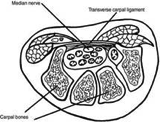Introduction
Carpal Tunnel Syndrome is due to excessive repetitive movements of the arms, wrists or hands. These excessive repetitive movements can cause injuries that could become chronic conditions. It is a common work-related injury. It is common because at work many people use forceful or repetitive hand movements.
What is the carpal tunnel?
The carpal tunnel is the passageway in the hand made up of the arching carpal bones (eight bones in the wrist) and the ligament connecting the pillars of the arch.

What causes carpal tunnel syndrome?
Carpal tunnel syndrome occurs when the median nerve, which relays sensation from the palm of the hand and fingers, becomes pinched. Pinching usually occurs by swelling of the nearby tendons. When the nerve is pinched, numbness and sometimes pain of the fingers, hand and sometimes the forearm occurs.
Some specific causes of Carpal Tunnel Syndrome are :
- Normal wear and tear of the tissues in the hand and wrist.
- Diseases or illnesses.
- Broken wrist bones, bones that are out of place (dislocated bones), or new bone growth from healing bones that take up space in the carpal tunnel and put more pressure on the median nerve.
- Buildup of fluid in the carpal tunnel. This usually occurs during pregnancy or when a person has certain conditions such as rheumatoid arthritis or diabetes.
- Tumors or other growths in the wrist.
What are the symptoms of carpal tunnel syndrome?
The most common symptoms of carpal tunnel syndrome are :
- fingers become numb at night
- waking up with numbness and tingling in hands
- burning pain in hands or fingers
- burning pain that runs up the center of the forearm
In severe cases of carpal tunnel Syndrome, loss of feelings in the fingers can occur with atrophy of the muscles on the palm.
How is it diagnosed?
Diagnosis is frequently made based upon patients’ complaints and physical examination. Patients with diabetes, obesity, rheumatoid arthritis, lupus, hypothyroidism or multiple sclerosis may be more likely to develop carpal tunnel syndrome. These conditions affect the nerves directly, making them more vulnerable to compression.
How is it treated?
There are many treatment options. Treatments usually involve adjusting the way the person performs a repetitive motion. Some of the most common treatments are :
- Changing the frequency with which the person performs the repetitive motion.
- Changing the amount of time the person rests between periods of performing the repetitive motion.
- Doses of anti-inflammatory drugs.
- Injections of cortisone or steroids in their wrist to reduce swelling.
If the above treatments are not successful, surgery is another option. Surgery involves cutting the ligament at the bottom of the wrist, relieving the pressure.
How to prevent?
- Limit the amount of time the person performs the repetitive motion.
- Use wrist rests and keyboard trays.
| Last reviewed | : | 25 April 2012 |
| Writer | : | Dr. Azaiddin Akasah |
| Reviewer | : | Dr. Heselynn Hussein |







